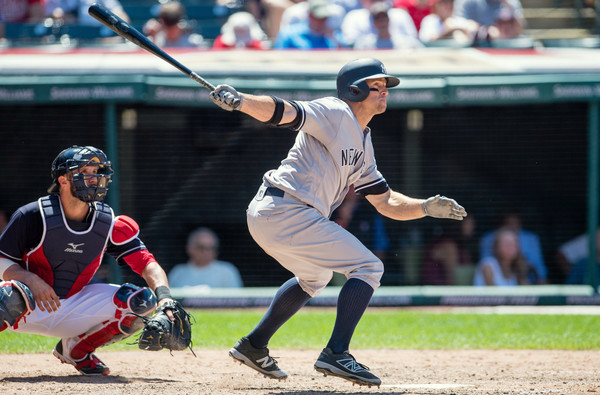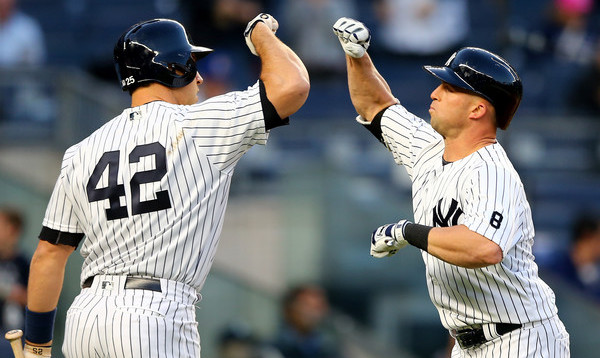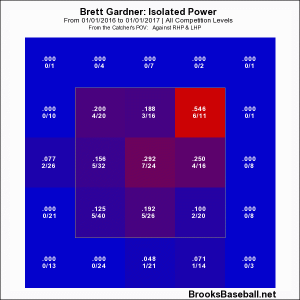
Being a sports fan means you’re going to make predictions or statements or give takes; with that comes a lot of being wrong. Most recently, I was most wrong about fellow former UConn Husky and current Detroit Piston Andre Drummond. After he left Storrs following his freshman year, I thought he’d struggle in the NBA thanks to a lack of a refined offensive game. I was wrong and I was very glad to be wrong. Before him, I was (somewhat) wrong about Brett Gardner.
Though I’ve long been a fan of Gardner’s, I wasn’t always sure how he’d fare long-term in Major League Baseball. Despite a good batting eye that helped him get on base just about everywhere he played, I had concerns regarding his general lack of power. I thought that once he got through the league a time or two, pitchers would be able to knock the bat out of his hands by challenging him, thus negating his good eye at the plate and limiting his effectiveness as a hitter. I was wrong; Gardner’s lasted a long time in the league and has been a productive player for most of that time.

Part of that productivity came from a power surge in 2013 that lasted through 2015. From 2013-2015, he had ISOs of .143, .166, and .140 after never having an ISO greater than .110 from 2008-2012. Additionally, 2014 and 2015 saw him hit 17 and 16 homers respectively. This isn’t Barry Bonds level power or anything, but for Gardner, this was groundbreaking stuff. In 2016, though, that power reservoir has seemingly dried up.
This year, his ISO has dropped down to .116, his lowest since a .110 mark in 2011 — not including the partial season in 2012. Per FanGraphs, ZiPS rest-of-season projections forecast Gardner to hit only four more homers this year, bringing his total up to 11. While that would be higher than any non-2014/15 year, it’s still a drop from the last two years, though the ISO drop is the more pronounced of the two. As proof of that, let’s take a look at Gardner’s extra-base hit rate as a percentage of his hits. In 2014, 35.2% of his hits went for extra bases. That rate dropped to 30.4% in 2015 and is down another 5% to 25.3% this year.
He’s dropped back down to relatively normal levels of his power so it’s not horribly alarming, but it’s still disappointing to see since that added dimension of power helped make Gardner an even more valuable player. As such, it’s still worth looking at why these numbers have dropped back down. When Gardner was going right with his homers, he was pulling inside pitches over the short porch in right field at Yankee Stadium. Let’s take a look at Gardner’s pull numbers over the last three years, incorporating HR/FB%; Hard Hit%; and ISO (all per FanGraphs):
| Year | HR/FB% | Hard Hit% | ISO |
| 2014 | 29.4 | 37.3 | 0.385 |
| 2015 | 62.5 | 28.2 | 0.367 |
| 2016 | 37.5 | 24.5 | 0.263 |
While Brett is still hitting for good power to his pull field, it’s down significantly from the previous two years. 2015 was a little fluky with regards to the HR/FB% as Gardner tended not to hit many fly balls last year; the ones he did hit, however, left the park at an insanely high rate. It’s expected that there’s been a drop off this year, but that’s been coupled with a steadily dropping hard hit rate to the pull field. Why might this be? Well, intuitively, when you’re pulling the ball, you’re doing damage on inside pitches. Is that happening for Gardner this year compared to 2014-15? Not so much.
There’s Gardner’s 2014-2015 zone profile by ISO. By taking a look at the inside pitches in the zone, we see ISOs of .300; .281; and .361. He also did damage on pitches actually inside and out the zone, ISOing .471 on those pitches; he was even able to golf some low/in pitches out of the zone for a .286 ISO. Now let’s look at 2016.
That inside power has seemingly disappeared in 2016. Up and in, in the zone, Gardner’s still doing damage: .546 ISO. Middle-in, in the zone is still solid at .250, but there’s been a drop off from 2014-15. The low-in, in the zone and the two out of zone locations have produced virtually no power.
There’s no quick and easy answers in baseball, but a rough estimate for why Gardner’s power has dropped this year is that he just isn’t doing damage on inside pitches and isn’t pulling the ball with as much authority to his pull field as he did in the previous two seasons. Despite the lack of power, Gardner has still been reasonably productive in 2016. He’s walking at his highest rate since 2011 (again, discounting 2012’s limited scope) and striking out at his lowest rate since 2011. But the lack of power has Gardner’s wRC+ under 100 for the first time since 2011. While the team was nowhere near reliant on Gardner for power coming into 2016, the lack of it — and the general lack of production from Alex Rodriguez and Mark Teixeira — has been a disappointment. Hopefully next year, Gardner can regain his power stroke and increase his productivity.


Leave a Reply
You must be logged in to post a comment.